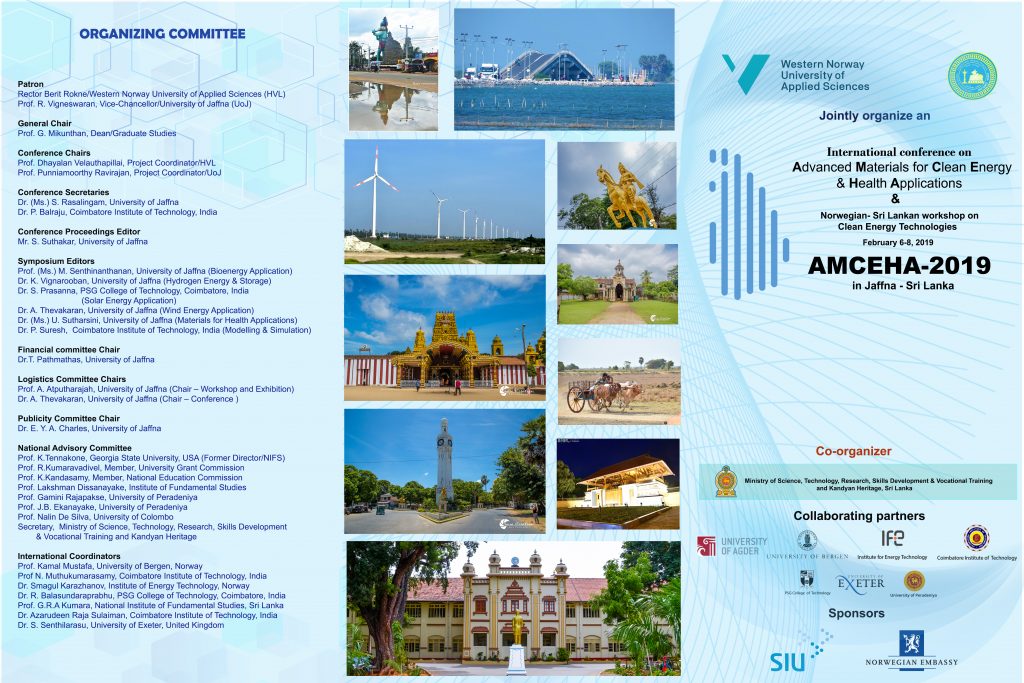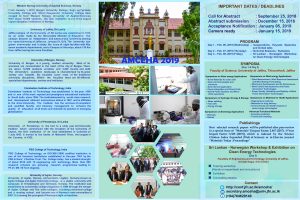ABOUT AMCEHA 2019
The growing world population and the environmental challenges demand more focus on clean energy and health technologies. Advanced nanomaterials have paved the way for innovation and new applications in the field of clean energy and health sector. As the demand for clean energy is going to be immense in the future and many countries consider transforming themselves into clean energy economies, it is of utmost interest for the research community to work on novel ideas and find solutions for the challenges facing the clean energy sector. Rapid progress in nanotechnology in the past decade has provided significant breakthroughs in the area of energy sector and health applications. The International Conference on Advanced Materials for Clean Energy and Health Applications (AMCEHA 2019) will provide a forum for exchange of technical and scientific information between international researchers in the field of materials for clean energy and health applications.
Photovoltaics have received increasing attention in the last decade from the research community as well as industry and solar energy is considered as a promising source of clean energy. Emerging areas in solar cell research such as dye sensitized, quantum dot sensitized, organic and perovskite solar cells have given hope in producing low cost and flexible alternatives for Si based solar technology. Idea of floating solar cell installations have also created enthusiasm among the industrial community.
Accurate modelling and simulation methodologies have helped the wind energy sector in efficient wind turbine installations. Rapid technological developments in the wind energy sector has reduced the cost of installation, maintenance and production of wind power, many nations have started investing in both inshore and offshore wind turbine facilities.
Energy storage is one of the challenges both the solar and wind energy sectors face, and storing the energy as Hydrogen is one of the solutions the research community is interested of. Technological developments in fabricating fuel cells and in Hydrogen production has paved the way for use Hydrogen as clean energy source in the transport sector. Biomass is another area of interest for the research community in producing carbon neutral energy.
Biomaterials and Tissue Engineering is a promising field of research interest and covers diverse fields such as medicine, biology, chemistry, materials science and engineering. Biomaterials can be used for drug discovery, tissue regeneration, organ development, regenerative medicines and so on. Production of biodegradable and biocompatible materials has become a fascinating area which could be used in dentistry, orthopedics and as a diagnostic tool in the field of medicine. The biennial symposium will be a promising, and another exciting event bringing together the researchers, clinicians, scientists, engineers and industrial personnel to establish new collaborations, knowledge transfer and discuss the recent scenario in promising biomaterials. Symposia on materials for regenerative medicine and drug delivery will be organized as part of the conference and will be led by internationally renowned experts in the field.
Computational modeling and software tools are increasingly important to realize nanomaterials for both clean energy and health applications. The fundamental techniques of theory, modeling, and simulation have undergone a revolution that parallels the extraordinary experimental advances on which the new field of nanoscience is based. The development of density functional algorithms, Quantum Monte Carlo techniques, ab initio molecular dynamics, advances in Classical Monte Carlo methods, mesoscale methods for soft matter, fast-multipole and multigrid algorithms have made computational modeling the best tool to study nanomaterials. The combination of new theoretical methods together with increased computing power has made it possible to simulate systems with millions of degrees of freedom. This conference will throw light on the computational modeling and simulation used to study about nanomaterials.

